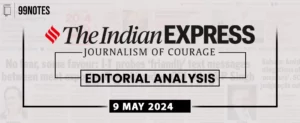Topic: GS1 – Geography – World’s physical geography Understanding ocean currents (esp. near India) is vital for UPSC as it impacts weather, climate (Indian subcontinent) and maritime activities. |
| Context: |
| ● Study of Indian Ocean floor improves understanding of currents, especially near the Maldives, which significantly affect deep ocean flow. |
Additional information on this news:
- A recent study by scientists at the Indian National Centre for Ocean Information Services (INCOIS) revealed the significant influence of Andaman and Nicobar Islands and the Maldives islands on Indian Ocean currents.
- Deep-swirling patterns in the ocean depths, opposite to surface currents, were discovered, altering direction and speed significantly.
- Scientists Raheema Rahman and Hasibur Rahaman conducted a study on Indian Ocean bathymetry, showing improvement in upper ocean salinity, temperature, and currents, especially near the coast.
- Accurate forecasts of oceanographic parameters like currents, temperature, and salinity are crucial for weather, climate prediction, and maritime industry.
- The study underscores the importance of bathymetry in enhancing understanding of ocean dynamics to improve ocean state forecasts, weather, and climate forecasts for Indian rim countries and the subcontinent.
- Titled ‘Impact of bathymetry on Indian Ocean circulation in a nested regional ocean model,’ the study was published in the Scientific Reports journal.
| PYQ: Explain the factors responsible for the origin of ocean currents. How do they influence regional climates, fishing and navigation? (200 words/12.5m) (UPSC CSE (M) GS-1 2015) |
| Practice Question: What role do the Andaman and Nicobar Islands and the Maldives islands play in influencing Indian Ocean currents? How does bathymetry contribute to our understanding of weather and climate forecasting? (150 Words /10 marks) |











